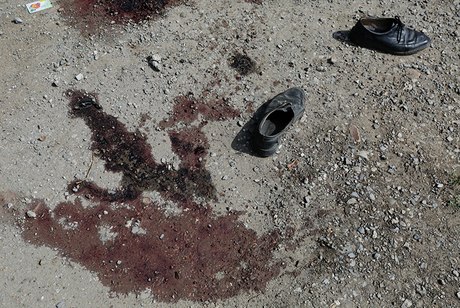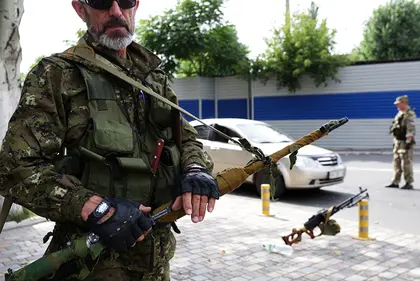At the same time,
Dutch forensic experts and monitors from the Organization for Security and
Co-operation in Europe (OSCE) visited the bodies of Malaysia Airlines flight 17
at the Torez train station some 40 miles east, where they are being held inside
refrigerated wagons and waiting to be transported to a secure location where
they can be identified.
The streets of Donetsk
were mostly empty all day, and rebels set up new block posts in the city to
control traffic. Residents were seen fleeing from the area around the train
station, suitcases in tow. All around, explosions from artillery reverberated,
and a dense cloud of black smoke rose from a car factory in the distance.
JOIN US ON TELEGRAM
Follow our coverage of the war on the @Kyivpost_official.
The courtyard of a residential
complex was a warzone marked with craters likely from Grad rockets mere meters from a
children’s swingset.

When 31-year-old Vlad
Kozlov opened the front door of his flat near Donetsk’s central railway station
en route to the institute where he teaches, two pieces of shrapnel from one of
the rockets struck him in the legs. Kozlov was taken to a local hospital, but
not before leaving sprawling blood stains on the stairs inside his apartment
building.
“He is going to have
an operation,” said Valentina Nikolayevna, his grandmother. “I hope he won’t become
disabled after this.”
Just 50 meters away,
another blood stain marked the place where a woman was killed by the same
rocket. Her body had been taken away, but her shoes remained at the site.

Sergey, a local
resident who refused to give his last name, showed the Kyiv Post a video taken
just after the incident of the woman’s mutilated body. “Now I want just to take
up a gun myself [and fight Kiev’s forces],” he said.
Sergey added that two
men were also killed in a yard of a school nearby.
“They were probably
trying to hide behind the trees there,” he said. The Kyiv Post saw the demolished
area where the men were found after the rocket attack, which lasted from 9
a.m. to about 1p.m., residents said. They said it was the first time they have
had to hide in their basements since war broke out in their region.
Locals here blame the
Ukrainian military for targeting residential areas. But the military has denied
operating in areas populated by civilians.
“We cannot shell there
even unintentionally, as we do not use such kind of artillery there,” Vladislav
Seleznev, a spokesperson for Kyiv’s “anti-terrorist operation” told the Kyiv
Post by phone on July 21. However, he confirmed the military made significant
gains in and around Donetsk on that day.

A group of insurgents
– men and women – took their positions just across the street from the yard
where the shelling happened. They were listening nervously to the sound of
artillery fire from the direction of Ukrainian positions southeast of the city.
The military is slowly tightening its ring around Donetsk and nearby Horlivka,
another rebel stronghold.
At about 5 a.m. on
July 21, the military captured the village of Pisky, an area on the outskirts
of Donetsk that insurgents had previously held. One of them told the Kyiv Post
he and his comrades had retreated during the Ukrainian bombardment in the early
morning hours. Three of their comrades were wounded
in the fight, but none of them had bee killed, he said.
Now the rebels are
digging in and preparing their response to a military attack they believe is
imminent.
“We have nowhere to
step back,” said a 40-year-old rebel who goes by the nom de guerre “Karabzon.” Born
in Donetsk, he said he took up arms months ago to fight for the separatist
cause. He said he was once had served in the border guard forces under the Soviet
Army.

Manning a block post with
him near the train station was a petite 27-year-old woman in military garb with
a Kalashnikov around her back, who asked to call her “Golub Mira” (pigeon of
peace). She said she had experience working as a nurse, and her main aim is to tend
to wounded rebels.
“But if needed, I’m
also ready to shoot,” she said.
In Torez, Three Dutch
investigators and OSCE officials inspected the refrigerated trains holding some
250 of the 298 bodies from the Malaysia Airlines flight 17, which is believed
to have been shot out of the sky on July 17.
Train station
employees opened the rickety doors of the railcars so they could peek inside. But
they did not go in the cars. “That would be disrespectful,” said one Dutch
investigator.
After visiting the
crash site some 10 miles north of Torez, in the village of Hrabove, they
told journalists they were impressed by the work of first responders – local emergencies
services workers who bagged and tagged the bodies along with a motley mix of
volunteers, including local miners.
Given the circumstances,
one investigator said, “they have done an incredible job.”
Editor’s Note: This article has
been produced with travel support from www.mymedia.org.ua, funded by the Ministry of Foreign Affairs of Denmark and implemented
by a joint venture between NIRAS and BBC Media Action, as well as Ukraine Media
Project, managed by Internews and funded by the United States Agency for
International Development. The content is independent of these organizations
and is solely the responsibility of the Kyiv Post.
You can also highlight the text and press Ctrl + Enter




